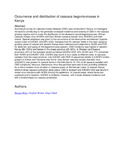Occurrence and distribution of cassava begomoviruses in Kenya
Abstract
SummaryA survey for cassava mosaic disease (CMD) was conducted in Kenya, to investigate the factors contributing to the generally increased incidence and severity of CMD in the cassava growing regions and to study the distribution of the disease's causal begomoviruses, African cassava mosaic virus (ACMV) and East African cassava mosaic virus (EACMV) and their strains. Special emphasis was given to the occurrence of the destructive recombinant Uganda variant strain of EACMV (EACMV-UG2). Samples from 91 farmers' fields in the main cassava-growing areas of coastal and western Kenya were collected and subjected to ELISA and PCR for detection and typing of the begomoviruses present. CMD incidence was highest in western Kenya (80–100%) and lowest in the Coast province (25–50%). In Western and Nyanza provinces, 52% of the samples tested contained EACMV-UG2, 22% ACMV and 17% contained both ACMV and EACMV-UG2. EACMV was found in four cases at different sites. In cassava samples from the coast province, only EACMV with DNA-A sequences similar to EACMV strains present in Kenya and Tanzania was found. East African cassava mosaic Zanzibar virus (EACMZV) was present in several farms in the Kilifi district. In 15% of all cassava samples with CMD symptoms, flexuous, filamentous virus-like particles were also found, providing evidence for a more complex virus situation in cassava grown at the Kenyan coast. In western Kenya, where intense cassava cultivation takes place, CMD is rampant and EACMV-UG2 was found in mixed virus infections with ACMV driving the epidemics. In coastal areas, where farms are scattered and in isolation, EACMV is endemic, however, with a lower disease incidence and with a limited impact to cassava production.
URI
https://doi.org/10.1111/j.1744-7348.2004.tb00373.xhttps://onlinelibrary.wiley.com/doi/abs/10.1111/j.1744-7348.2004.tb00373.x
http://r-library.mmust.ac.ke/123456789/1645
Collections
- Gold Collection [1026]

